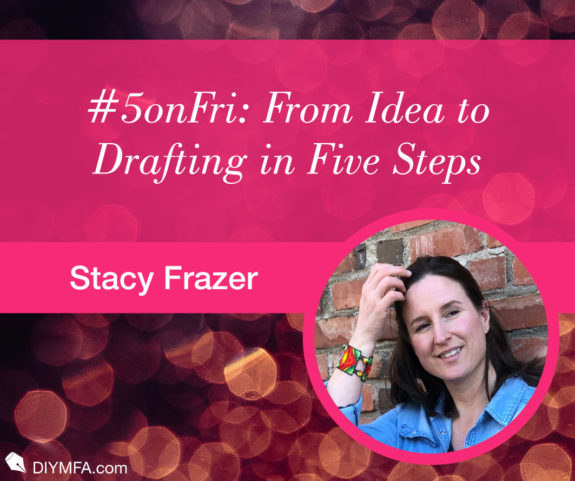You have an idea for a story. Maybe you’ve been kicking it around for years, or it hit you yesterday, but you’re unsure where to begin. Here are five steps to help you develop your story from idea to drafting your novel.
- Craft your premise
- Learn about your characters and uncover the story’s theme
- Discover the world
- Define the main conflict and plot
- Choose your narrative structure
Before diving in, examine why you want to write this book. Why are you willing to invest your energy and possibly years of your life into this idea? Dig for those answers and keep them close, because going from an idea to drafting a novel is a long and often arduous process. Remembering why you began and what it means to you will help reignite your fire when the writing gets hard.
What is a story? A quick review:
A story is an emotional experience. It follows a character who wants something badly, is willing to run the gauntlet to get it, and learns lessons that either change them internally, or the world around them.
A story contains five major elements: Character, Conflict, Plot, Theme, and Setting.
Think of the story as a container. The walls of the container are your setting. Inside, you have a character with a problem (conflict), and they go through a series of events (plot) to solve it. The problem, how they solve it, and who they become in the process speaks to the story’s message (theme).
Step 1: Craft Your Premise:
A premise is the nutshell statement of your story that defines the main character, their world, their wants and motivations, and the obstacles they will face in pursuing their goal. A good premise is the first layer of a strong story foundation, and you will expand on it as you progress through the remaining steps of taking your idea to drafting, so don’t worry if some components are missing when you begin.
Example: How to craft a premise using a modified version of Pixar’s Plot Sketch Formula.
There once was a __________ (descriptive characteristic, + emotional state/worldview) ________________(main character,) who lived in ____________ (setting) and wanted _________ (character desire at beginning of story).
One day the character’s life unexpectedly changed because of ____________ (event = inciting incident).
This event created a problem for the character, and because of this, the character wanted to _________ (new desire).
But the _____________ (antagonistic force/ core conflict) stands in their way.
Let’s use the movie Shrek to fill in the blanks.
A rude, self-isolating ogre once lived in a peaceful swamp and wanted to be left alone. One day, a talking donkey and a host of unwanted fairytale creatures invaded his home. The ogre wanted to eliminate his unwelcome guests and confronted the King to regain his land. But the King refused unless the ogre agreed to rescue a princess from a dragon.
Step 2: Learn about your characters and extrapolate the theme:
Identify your main character’s arc of change.
Characters create the story through their actions. Therefore, understanding what motivates them to act is essential.
Story is about change, especially character change. Understanding how your character will change internally will help define what the story is about (theme) and guide you in taking that idea to drafting your ending.
How to shape your main character’s arc:
Beginning of the Arc: At the beginning of the story, before the main character’s life is turned upside down by that unexpected event, ask these questions to determine your character’s personality, flaws, and false beliefs.
- What do they want for themselves? Why do they want it?
- What do they believe they can’t have?
- What beliefs do they have about themselves?
- What beliefs do they have about the people, places, and situations around them? What is the origin of those beliefs?
- What are they afraid of physically and emotionally? How do they protect themselves?
If you are uncertain of your character’s beginning emotional state but know where you want them to end up, you can work backward.
End of the Arc: Now ask what your character wants and believes because of the story events and lessons learned. How has this character changed from their baseline?
At the end of Shrek’s story, he wants to be with Fiona, embraces friendship, and believes love is worth the risk of rejection.
A note on side characters and antagonists:
Ask these questions of your main side characters, love interests, and antagonists. Consider how the relationships between your main character and other characters will evolve as the story progresses from idea to drafting your novel.
Theme:
The theme expresses what the story is about, the big takeaway for the reader. Many writers find the concept of theme obscure, but if we remember that the story is about change, we can simplify it. By defining the main characters’ arc of change, we can extrapolate the story’s central message, as with Shrek: love is worth the risk of rejection.
Step 3: Discover your character’s world.
The genre (the category of the book) you’re writing plays a great deal in how much worldbuilding you will need to do. Consider the world’s magical, technical, political, and socioeconomic factors, particularly if you write historical fiction, speculative, sci-fi, or fantasy.
Read extensively in your genre. Focus on identifying how the world and setting add to the feel of the book.
Questions to consider initially and build on:
- Where does your character live? How do they feel about it?
- When does the story take place?
- How does the setting add to the tone of the book?
- How can elements of the setting cause problems for the main character or enhance the main conflict?
Step 4: Define the main conflict and plot.
Conflict: Define the main conflict
Conflict creates change by forcing characters to act. After their life turns upside down, what big problem will the main character spend the rest of the book trying to fix? This represents the story’s core conflict, driven by the opposing or main antagonistic force.
There are two types of conflict in a story: external and internal. Compelling stories need both.
External is the character struggling against an outside force, which can be another character, society, nature, technology, fate, or something otherworldly.
Internal conflict is the character struggling against themselves. These are the character’s insecurities and moral dilemmas.
The key is to create meaningful conflict in your story: craft external conflicts that put pressure on the character’s internal struggle; to do that, you must have done your character work.
Plot: Map out the events in the story that manifest as a result of the main conflict.
As your character embarks on their adventure, you want them to face increasingly complex problems, which force them to make hard decisions to reach their goal. These problematic events are your plot, and each major plot event should progressively challenge the character internally and externally.
For example, your character may need money to pay the ransom for their son, so they steal from their boss. But then the wolf shows up at the door to collect gambling debts, and they must choose their life or their child’s.
You don’t need to know every single story event to start drafting. Still, if you pin down a few key moments where things get really tough for your character, it will give you a solid writing framework and force your character to make hard choices that advance the plot naturally.
Key events to know before building on an idea to drafting:
The first insult to the status quo of the character’s life (inciting incident): Creates the initial problem of the story that is linked to the plot.
The first turning point: an event that results in the main character deciding to fully engage in the story’s plot to solve the conflict.
The midpoint: the character suffers a false victory or defeat, and the stakes increase dramatically.
Climax: How the character solves the main story conflict.
Resolution: The parting shot of the character’s life now that the conflict is solved, and they have embraced a new way of living (good or bad).
Step 5: Choose your narrative structure
Decide who will narrate the story and how the information will unfold to the reader. Consider your story’s timeline and which POV and tense you will use, how many narrators you need, and how much they know about the story’s events.
Don’t be afraid to test out different POVs and tenses. Find what fits your story, characters, and tone.
Don’t be in a rush to write the story. Idea to drafting takes time.
Avoid false starts and frustrations by spending a little more time up front on the right things: premise, characters arc, world, conflict, plot, theme, and narrative structure. Following these steps will help you draft your novel with more context and confidence so you type those amazing final words: THE END.
For more information on developing a story idea for a novel, download Stacy’s free e-book: First Draft Confidence: Workbook and Resource Guide.

Stacy Frazer is a formerly repressed creative soul turned speculative fiction writer, YA fantasy author, Author Accelerator certified book coach, and the founder of Write It Scared. Her mission is to help fiction writers let go of the self-doubt spiral and find clarity and confidence in their stories so they can finish their books. Stacy firmly believes that the only creative license required to write a novel is one’s lived experience and that you can learn all the tools to craft a book that makes you proud!
When not writing, reading, or working with writers, you can find Stacy hanging with her daughter or on the trail with her big goofy labrador, Gus Gus. To connect with Stacy, please visit her website: www.writeitscared.co. You can also email her at www.stacy@writeitscared.co or follow her on Instagram @WriteitScared.







